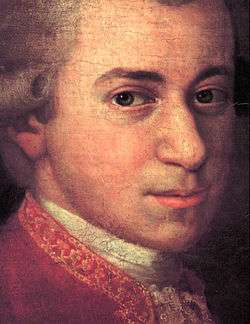Serenade No. 4 (Mozart)

The Serenade No. 4 in D major, K. 203/189ba was written in August 1774 by Wolfgang Amadeus Mozart for ceremonies at the University of Salzburg.[1] It is nicknamed Colloredo after Mozart's patron, Count Hieronymus von Colloredo. The work is very similar to K. 204 serenade composed for Salzburg the following summer.
Structure
The serenade is scored for two oboes (doubling flutes), bassoon, two horns, two trumpets and strings. There are seven movements:
- Andante maestoso - Allegro assai
- [Andante]
- Menuetto
- [Allegro]
- Menuetto
- [Andante]
- Menuetto
- Prestissimo
The March in D, K. 237/189c, was used as an introduction or exit for this work.[1]
The second, third and fourth movements all feature the solo violin prominently, forming a three-movement violin concerto within the serenade. This is similar to the K. 204 serenade from the previous year. These movements are set apart from the rest of the serenade by their choice of keys (B-flat major, F major, B-flat major).[1]
The trio of the second minuet features an independent solo bassoon part.
Like most of his orchestral serenades, a symphony was arranged from a subset of the serenade's movements. The "Serenade Symphony" for this work consists of movements one, six, seven and eight.[2]
Notes
External links
- Serenade in D KV 203: Score and critical report (German) in the Neue Mozart-Ausgabe
